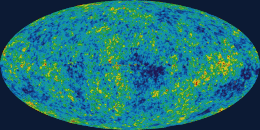January 28, 2009 feature
New Data Suggests We Don’t Live in a Void, and Supports Dark Energy

(PhysOrg.com) -- An alternative proposal to dark energy in which the Earth sits near the center of a large void is undergoing scrutiny, and the results show that void models fit poorly with observed data. Nevertheless, scientists say that more research will be needed to determine if void models, dark energy, or something else can accurately explain how the universe is expanding at an accelerating rate.
Almost a decade ago, theorists proposed a void model as an alternative to the repulsive force of dark energy, an unknown force that is not well understood. According to the void model, much of the visible universe lies in a giant void that contains very little matter compared to the matter density outside the void, which is difficult to observe. The void’s low density means the gravitational “braking” force is weak in the void. This creates the illusion that the visible universe is expanding faster than it used to; however, the actual change is not a change over time, but over space.
Scientific data aside, void models have an important philosophical implication: that the Earth occupies a special place at the center of the visible universe. This contradicts the Copernican principle, which says that we should not be at a special place, and has been extended to state that the universe is homogenous. The Copernican principle has served as a pillar for modern astronomy, and if it weren’t true, then astronomers could not rely on local measurements to learn about universal properties.
Now a team of researchers from the University of British Columbia has compared new data with the predictions of various void models and standard dark energy models. Post-doctoral fellows Jim Zibin and Adam Moss, along with Professor Douglas Scott, studied supernova, cosmic microwave background, and baryon acoustic data from the early universe, and found that altogether the data fits standard dark energy models much more closely than void models. Their study is published in a recent issue of Physical Review Letters.
“Our study addresses one of the greatest mysteries in cosmology today - the apparent acceleration of the Universe's expansion,” Zibin told PhysOrg.com. “The standard explanation, dark energy, is itself so puzzling that researchers have tried hard to find viable alternatives, but with very few successes. Our study shows that it is extremely unlikely that one such alternative, void models, can be made to work. This strengthens the case that the acceleration is real and is due to dark energy.”
The researchers examined two kinds of void models: unconstrained and constrained (in which the density distribution is limited). They found that unconstrained voids can fit the CMB and supernova data, although this comes at a price of requiring a very low Hubble constant - which ultimately rules out the unconstrained voids. Constrained voids also run into problems, as they require finely-tuned features in order to fit the CMB data. However, standard dark energy models closely match the CMB data. Further, the baryon acoustic data is at odds with the likeliest void models, but agrees very well with standard dark energy models. As Zibin explained, this type of analysis is only possible with the ability to gather very precise data, as in the current era of “precision cosmology.”
“More than about a decade ago, the fundamental parameters that describe the Universe on the largest scales, such as the expansion rate and the amount of spatial curvature, were only known with poor accuracy,” he said. “Since then, precision measurements of the CMB by satellite and massive automated sky surveys on the ground have revolutionized cosmology by pinning those parameters down with high precision. It seemed very surprising to us that cosmological models such as the void models, which are so drastically different from standard dark energy models, could still fit all of this precision data.”
The scientists conclude that it is quite extraordinary that standard dark energy models can describe a wide variety of observations so well, without requiring finely tuned parameters. In investigating the robustness of void models, the researchers have in fact solidified the conventional view that dark energy causes the acceleration of the universe.
“Further refinements in measurements of the CMB and even bigger sky surveys are planned, and will help us to understand the acceleration better,” Zibin said. “It may turn out that even the improvements planned in the next decade or so won't distinguish the simplest form of dark energy, the cosmological constant, from other forms. On the other hand, we may be fortunate and learn soon what dark energy really is.”
More information: Zibin, James P.; Moss, Adam; and Scott, Douglas. “Can We Avoid Dark Energy?” Physical Review Letters 101, 251303 (2008).
Copyright 2008 PhysOrg.com.
All rights reserved. This material may not be published, broadcast, rewritten or redistributed in whole or part without the express written permission of PhysOrg.com.





















